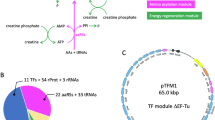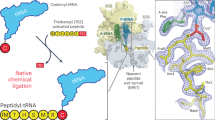Abstract
THE inhibition of protein synthesis by cycloheximide seems to occur at some stage later than the formation of aminoacyl-tRNA and its subsequent transfer to the ribosome1. Studies of the action of cycloheximide on intact cells2,3 have led to the proposal that the inhibitor has two sites of action at the ribosome level, one involving chain initiation and the other chain elongation. Using a cell-free protein-synthesizing system, we4 have observed that cycloheximide can inhibit polysome aggregation in much smaller doses than are needed to prevent chain elongation. With this system, we also observed that the action of the inhibitor on chain elongation could be partially reversed by adding high concentrations of glutathione to the incubation medium. This communication presents evidence that the site of this action of cycloheximide and its reversal by glutathione is the sulphydryl-dependent enzyme transferase II. Skogerson and Moldave5 have suggested that transferase II is identical with translocase, an enzyme responsible for transferring the peptidyl-tRNA from the acceptor to the peptidyl site on the ribosome, with concomitant hydrolysis of GTP. We have now demonstrated that this specific hydrolysis of GTP is inhibited by cycloheximide, and that this effect can also be partially reversed by raising the concentration of glutathione in the medium.
This is a preview of subscription content, access via your institution
Access options
Subscribe to this journal
Receive 51 print issues and online access
$199.00 per year
only $3.90 per issue
Buy this article
- Purchase on Springer Link
- Instant access to full article PDF
Prices may be subject to local taxes which are calculated during checkout
Similar content being viewed by others
References
Siegel, M. R., and Sisler, H. D., Biochim. Biophys. Acta, 87, 83 (1964).
Lin, S. Y., Mosteller, R. D., and Hardesty, B., J. Mol. Biol., 21, 51 (1966).
Godchaux, W., Adamson, S. D., and Herbert, E., J. Mol. Biol., 27, 57 (1967).
Baliga, B. S., Pronczuk, A. W., and Munro, H. N., Fed. Proc., 27, 766 (1968).
Skogerson, L., and Moldave, K., Fed. Proc., 27, 397 (1968).
Wettstein, F. O., Staehelin, T., and Noll, H., Nature, 197, 430 (1963).
Skogerson, L., and Moldave, K., Biochim. Biophys. Res. Commun., 27, 568 (1967).
Gasior, E., and Moldave, K., J. Biol. Chem., 240, 3346 (1965).
Moldave, K., Methods in Enzymology (edit. by Colwick, S. P., and Kaplan, N. O.), 8, 757 (Academic Press, 1963).
Baliga, B. S., Pronczuk, A. W., and Munro, H. N., J. Mol. Biol., 34, 199 (1968).
Conway, W. T., and Lipmann, F., Proc. US Nat. Acad. Sci., 52, 1462 (1964).
Fellicetti, L., Colombo, B., and Baglioni, C., Biochim. Biophys. Acta, 119, 120 (1966).
Sutter, R. D., and Moldave, K., J. Biol. Chem., 241, 1698 (1966).
Nishizuka, Y., and Lipmann, F., Arch. Biochem. Biophys., 116, 344 (1966).
Author information
Authors and Affiliations
Rights and permissions
About this article
Cite this article
MUNRO, H., BALIGA, B. & PRONCZUK, A. In vitro Inhibition of Peptide Synthesis and GTP Hydrolysis by Cycloheximide and Reversal of Inhibition by Glutathione. Nature 219, 944–946 (1968). https://doi.org/10.1038/219944a0
Received:
Issue Date:
DOI: https://doi.org/10.1038/219944a0
Comments
By submitting a comment you agree to abide by our Terms and Community Guidelines. If you find something abusive or that does not comply with our terms or guidelines please flag it as inappropriate.



